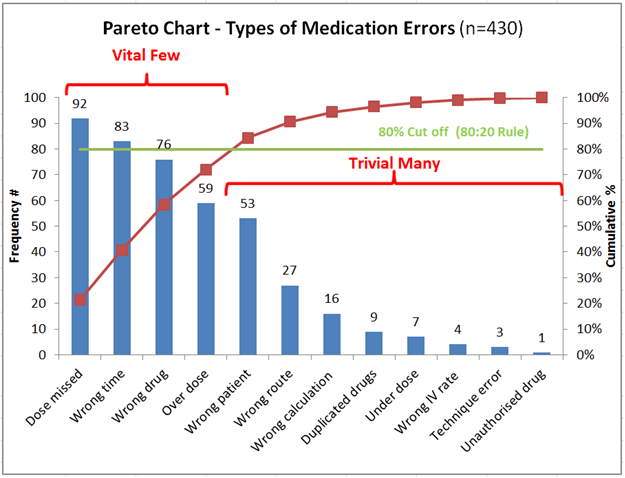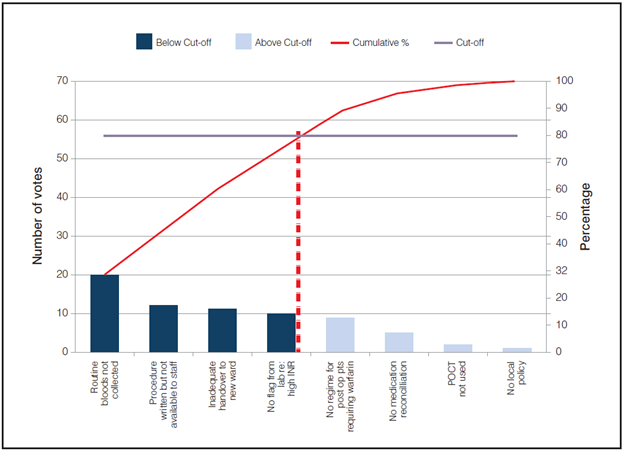Pareto Charts & 80-20 Rule
The Pareto Chart is a very powerful tool for showing the relative importance of problems.
It contains both bars and lines, where individual values are represented in descending order by bars, and the cumulative total of the sample is represented by the curved line. An 80% cut off line is also included to indicate where the 80/20 rule applies i.e. the vital few factors that warrant the most attention sit under the 80% cut off line.
Information can be collected initially in the form of a Tally Sheet via an audit and the data displayed in a Pareto Chart (see Figure 1). Data can also be collected via voting from team members after a brainstorming session (see Figure 2).
Figure 1: Pareto Chart – Audit of types of medication errors

80/20 Rule – The Pareto Principle
The 80/20 Rule (also known as the Pareto principle or the law of the vital few & trivial many) states that, for many events, roughly 80% of the effects come from 20% of the causes. Joseph Juran (a well regarded Quality Management consultant) suggested the principle and named it after the Italian economist Vilfredo Pareto, who noted the 80/20 connection in 1896.
Vilfredo Pareto showed that approximately 80% of the land in Italy was owned by 20% of the population. Pareto also observed that 20% of the peapods in his garden contained 80% of the peas. According to the Pareto Principle, in any group of things that contribute to a common effect, a relatively few contributors account for the majority of the effect. Commonly, it is found that:
- 80% of complaints come from 20% of customers
- 80% of sales come from 20% of clients
- 80% of computer crashes come from 20% of IT bugs
The ordering in a Pareto Chart helps identify the 'vital few' (the factors that warrant the most attention i.e. factors whose cumulative per cent (dots) fall under the 80% cut off line) from the 'trivial many' (factors that, while useful to know about, have a relatively smaller effect i.e. cumulative per cent dots that fall above the 80% cut off line).
Using a Pareto diagram helps a team concentrate its efforts on the factors that have the greatest impact. It also helps a team communicate the rationale for focusing on certain areas.
The example in Figure 1 (above) shows a Pareto Chart of types of medication errors. An audit of 430 medication errors was conducted to determine the categories (types) of errors and their frequency. The results were collected initially in a Tally Sheet then the data was placed in descending order of frequency in a Pareto Chart Template in Excel.
The types of errors that fall under the 80% cut off line indicate the 'vital few' types of medication error that should be addressed as a priority as they contribute most to the problem ie:
- Dose missed
- Wrong time
- Wrong drug
- Over dose
The types of medication errors that fall above the 80% cut off line are known as the 'trivial many' and are generally seen as not a high priority to address when compared to the 'vital few' factors. However, some of the 'trivial many' factors may be simple to address (low hanging fruit) and therefore may be acted upon earlier rather than later. The example in Figure 2 (below) shows a Pareto Chart of team votes.
After a brainstorming session a team has voted on what they believe most contributes to patients not being prescribed the correct anticoagulant dose. A total of 70 votes were counted. The most votes is represented by the highest frequency (the first bar) in the Pareto chart which is 'Routine bloods not collected'.
The dark blue bars indicate the 'vital few' reasons and these should be acted on as a priority as opposed to the reasons in the less frequent bars which are coloured light blue.
Figure 2: Pareto Chart – Voting from team on "Reasons patients' not prescribed correct anticoagulant dose"

To learn more about the Pareto charts, please refer to the Institute for Healthcare Improvement website. You may need to take a moment and register with the IHI for more in-depth information.
Video links: Introduction to Measurement for Improvement – Pareto Charts
Additional resources
Check the CEC Events Calendar for upcoming Measurement for Improvement webinars and workshops.
Your local Clinical Governance Unit may also have web-based resources or coaching services available.
Institute for Healthcare Improvement (IHI) video links
Feedback
Was this quality tool webpage useful? Do you have suggestions on how we might make it even better?
Please provide us with your feedback via this short evaluation survey.
